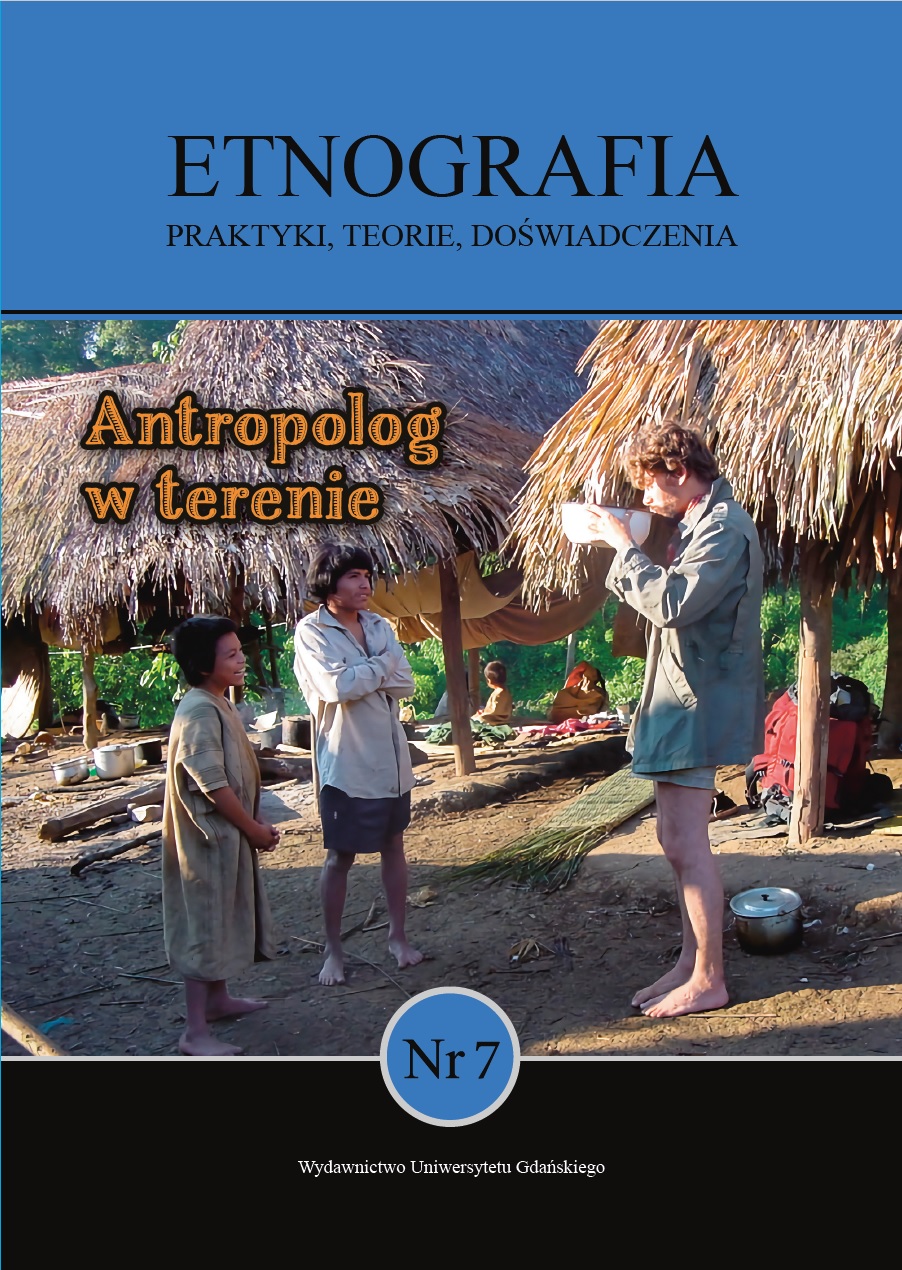Papuzie węże, wężowa cykada. O międzygatunkowym podzielaniu właściwości w etnozoologiach i kosmologiach Indian i Metysów Amazonii
DOI:
https://doi.org/10.26881/etno.2021.7.18Słowa kluczowe:
ethnozoology, cultural anthropology, lowland South America, two-striped forest-pitviper, lantern-flyAbstrakt
In this article, I present two examples of animals which, according to the Matsigenka and other native and mestizo Amazonians, share important properties with other, unre- lated (from the Western, or scientific point of view) animal species. The first example con- cerns the two-striped forest-pitviper (Bothrops bilineatus), which the Matsigenka and some other indigenous peoples associate with several species of parrots. According to the indig- enous view, there exist several „species” (ethnospecies) of the two-striped forest-pitviper, each of them sharing color patterns with particular parrot species. The second example concerns the lantern-fly (Fulgora laternaria, Fulgora spp.), an insect which in many parts of South America is considered a deadly, venomous snake in cicada-like form.
Downloads
Bibliografia
Berlin, B., O’Neill, J.P. (1981). The Pervasiveness of Onomatopeia in Aguaruna and Huam- bisa Bird Names. Journal of Ethnobiology, 1(2), 238–261.
Branner, J.C. (1885). The Reputation of the Lantern Fly. The American Naturalist, 19(9), 835–838.
Caballero Ardilla, E. (2018). Los bulos: Su efecto potencial en la salud de los pueblos. https://eduardocaballeroardila.files.wordpress.com/2018/09/los-bulos-su-efecto-potencial-en-la-salud-delos-pueblos.pdf
Caiuby Novaes, S. (2013). Corpo, imagem e memória: Reflexões a partir de duas fotos do funeral Bororo. W: L. Mammi & L. Schwarcz (eds.), 8 x fotografia (s. 113–131). São Paulo: Companhia de Letras.
Carrillo de Espinoza, N. (1970). Contribución al conocimiento de los reptiles del Perú (Squamata, Crocodylia, Testudinata: Reptilia). Lima: Universidad Nacional Mayor de San Marcos.
Costa Neto E., Pacheco, J. (2003). Head of Snake, Wings of Butterfly, and Body of Cicada: Impressions of the Lantern-Fly (Hemiptera: Fulgoridae) in the Village of Pedra Branca, Bahia State, Brazil. Journal of Ethnobiology, 23(1), 23–46.
Descola, P. (1997). The Spears of Twilight: Life and Death in the Amazon Jungle. London: Flamingo.
Etheridge, K. (2011). Maria Sibylla Merian and the Metamorphosis of Natural History. Endeavour, 35(1), 15 21.
Goemans, G. (2006). The Fulgoridae (Hemiptera, Fulgoromorpha) of Guatemala. W: E.B. Cano (ed.), Biodiversidad de Guatemala, t. 1 (s. 337–344). Guatemala: Universidad del Valle de Guatemala.
Holguín, H. (2012). Si lo pica la machaca tiene que hacer el amor o muere. El Especta- dor. 13.12.2012. https://www.elespectador.com/henry-holguin/si-pica-machaca-tiene-hacer-el-amor-o-muere-articulo-392229
Icochea, J. i in. Amphibians and Reptiles: Biodiversity Assessment at the Pagoreni Well Site. W: A. Alonso, F. Dallmeier (eds.), Biodiversity Assessment and Long-Term Monitoring, Lower Urubamba Region, Peru. T. 3. Pagoreni Well Site: Assessment and Training (s. 99–116). Washington DC: Smithsonian Institution & MAB Biodiversity Program.
Janzen, D.H., Hogue, C.C. (1983). Fulgora laternaria (Machaca, Peanut-Head Bug, Lantern Fly). W: D.H. Janzen (ed.), Costa Rican Natural History (s. 726–727). Chicago: University of Chicago Press.
Jaroniewski, W. (1988). Jadowite węże świata. Warszawa: Wydawnictwa Szkolne i Pedagogiczne.
Jensen, A.A. (1988). Sistemas indígenas de classificação de aves: Aspectos comparativos, ecológicos e evolutivos. Belém-Pará: Museu Paraense Emílio Goeldi.
Jernigan, K., Dauphiné, N. (2008). Aguaruna Knowledge of Bird Foraging Ecology: A Com- parison with Scientific Data. Ethnobotany Research and Applications, 6, 93–106.
Johnson, A. (2003). Families of the Forest: The Matsigenka Indians of the Peruvian Amazon. Berkeley-Los Angeles-London: University of California Press
Juszczyk, W. (1986). Mały słownik zoologiczny: Gady i płazy. Warszawa: Wiedza Powszechna. Kairski, M., Wołodźko, M. (1995). Antropologizacja etnologii a badania kultur pierwot- nych. Dyscyplina w okresie przełomu. W: A. Posern-Zieliński (red.), Etnologia polska między ludoznawstwem a antropologią (s. 69–81). Poznań: Wydawnictwo Drawa.
Kricher, J. (2008). Un Compañero Neotropical: Una introducción a los animales, plantas y ecosi-stemas del trópico del nuevo mundo. Colorado Springs: American Birding Association.
Landerman, P. (1973). Vocabulario quechua del Pastaza. Yarinacocha: Instituto Lingüístico de Verano.
Martín, M., Choclote, J. (2009). Amazonía: Guía ilustrada de flora y fauna. Iquitos-Lima: Proyecto Araucaria XXI Nauta & Serigráfica Industrial S.A.
Mendoza Orellana, A. (ed.) (2012). Sabiduría de la cultura kichwa de la Amazonía ecuatoriana. T. 2. Área de estudios socioculturales. Cuenca: Universidad de Cuenca & UNICEF.
Michalski, S.F. (1934). Latarnik. W: S.F. Michalski (red.), Encyklopedja Powszechna Ultima Thule, t. 6 (s. 356). Warszawa: Wydawnictwo Ultima Thule.
Nies, J. (1986). Diccionario piro: Tokanchi gikshijikowaka-steno. Yarinacocha-Pucallpa: Instituto Lingüístico de Verano.
O’Brien, L.B. (2002). The Wild Wonderful World of Fulgoromorpha. Denisia, 4, 83–102. Papavero, N., Teixeira, D. (2017). Early (17th and 18th Centuries) Drawings of Lantern-Flies and Mentions of Their Bioluminescence (Fulgora spp., Hemiptera, Homoptera, Fulgoridae). Arquivos de Zoologia, 48(3), 95–113.
Pascoe, F.P., (1864). Proceedings of April 4, 1864. Journal of Proceedings of the Entomological Society of London, 13–20.
Petiza, S. i in. (2013). Etnoentomología baniwa. Boletín de la Sociedad Entomológica Aragonesa, 52, 323–343.
Pieters, F.F.J.M., Winthagen, D. (1999). Maria Sibylla Merian, Naturalist and Artist (1647–1717): A Commemoration on the Occasion of the 350th Anniversary of Her Birth. Archives of Natural History, 26(1), 1–18.
Razowski, J. (1987). Słownik entomologiczny. Warszawa: Państwowe Wydawnictwo Naukowe.
Rojas Zolezzi, E. (2002). Las clasificaciones asháninka de la fauna del Piedemonte Central: Un caso de diferentes niveles de aproximación. Bulletin de l’Institut Français d’Études Andines, 31(2), 185–212.
Schulenberg, T.S. i in. (2010). Birds of Peru. Princeton-Oxford: Princeton University Press. Shepard, G.H., (1999). Pharmacognosy and the Senses in Two Amazonian Societies, praca doktorska. Berkeley: University of California.
Shepard, G.H. i in. (2001). Rain Forest Habitat Classification among the Matsigenka of the Peruvian Amazon. Journal of Ethnobiology, 21(1), 1–38.
Snell, B.A. (2011). Diccionario matsigenka-castellano con índice castellano, notas enciclopédicas y apuntes gramaticales. Lima: Instituto Lingüístico de Verano.
Świerk, K. (2012a). Zwierzęta, rośliny i minerały w magii miłosnej Indian Jívaro. Etnobiologia Polska, 2, 39-58.
Świerk, K. (2012b). Niewidzialny łucznik: Ofiologia Indian Matsigenka. Zwierciadło Antropologiczne: Rocznik Katedry Etnologii i Antropologii Kulturowej Uniwersytetu Szczecińskiego, 1, 141–154.
Torres Carvajal, O. i in. (2018). Reptiles de Ecuador: Guía dinámica de especies. Quito: Pontificia Universidad Católica del Ecuador.
Viveiros de Castro, E. (1998). Cosmological Deixis and Amerindian Perspectivism. Journal
of the Royal Anthropological Institute, 4(3), 469–488. Wikipedia, [dostęp 2020.05.29] Fulgora laternaria https://es.wikipedia.org/wiki/Fulgora_laternaria
Pobrania
Opublikowane
Wersje
- 2023-10-17 - (2)
- 2021-12-23 - (1)
Jak cytować
Numer
Dział
Licencja
Czasopismo wydawane jest na licencji Creative Commons Uznanie autorstwa-Na tych samych warunkach 4.0 Międzynarodowe.

 Uniwersyteckie Czasopisma Naukowe
Uniwersyteckie Czasopisma Naukowe








